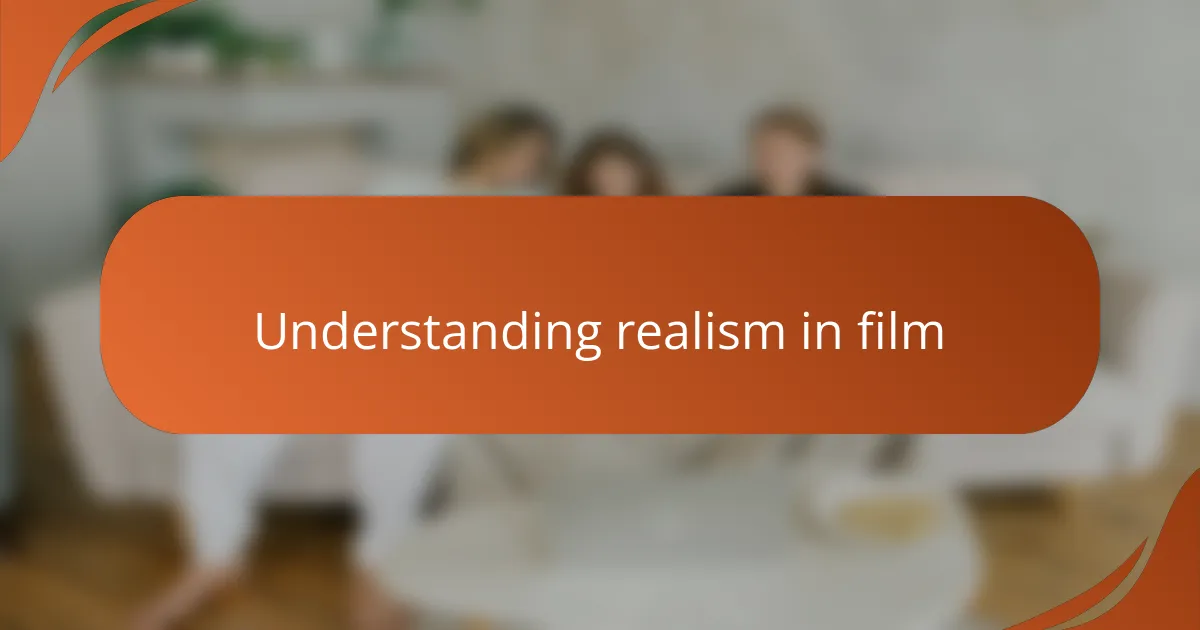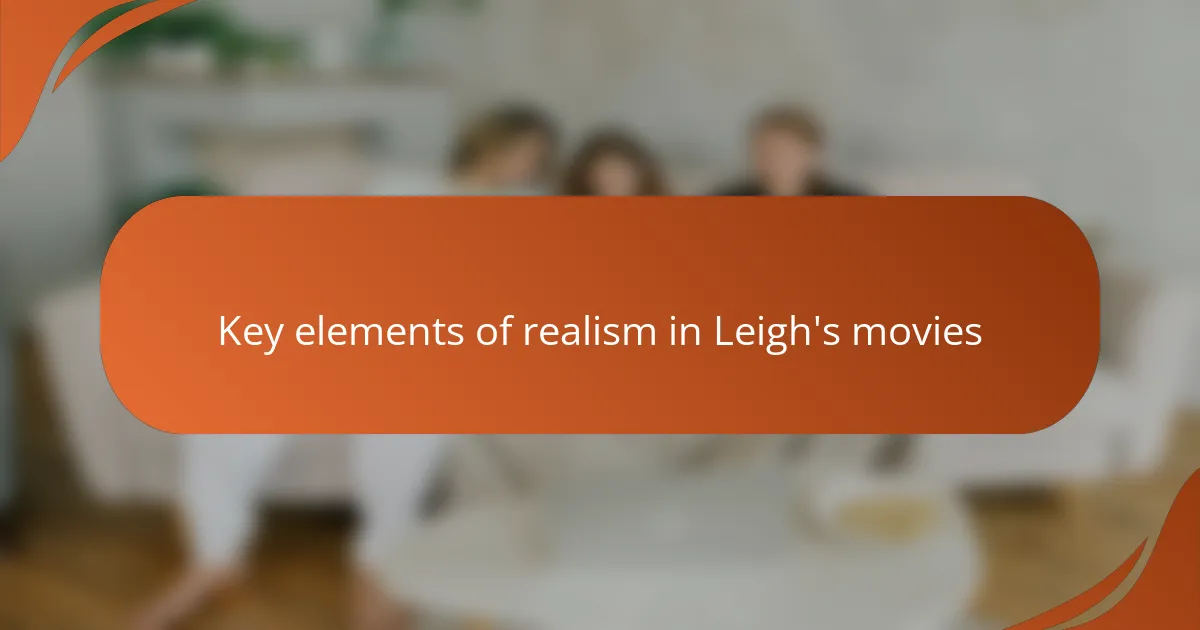Key takeaways
- Realism in film captures everyday life, focusing on authenticity and raw emotions rather than glamorization.
- Mike Leigh’s directing style emphasizes improvisation and the importance of unscripted, organic interactions among characters.
- Key elements of realism in Leigh’s films include natural dialogue, mundane actions infused with emotional weight, and relatable, flawed characters.
- Analyzing movie reviews benefits from focusing on language describing emotional subtlety and the balance between narrative and realism.

Understanding realism in film
Realism in film often feels like a window into everyday life, capturing the raw and unpolished moments that we usually overlook. Have you ever watched a scene that made you pause because it felt just like real life, with all its imperfections and subtle emotions? That sense of authenticity is what I believe defines realism—films that don’t glamorize or dramatize but instead reveal the ordinary truths beneath the surface.
From my experience, realism requires more than just naturalistic acting or settings; it’s about the filmmaker’s choice to highlight the mundane and the messy parts of human existence. It’s in the way characters speak, the pauses they take, and the small details that might seem insignificant but carry emotional weight. When I watch a film that nails this, I feel an intimate connection, as though I’m sharing a slice of someone else’s reality.
But why does realism in film resonate so deeply? I think it’s because it mirrors our own lives, allowing us to see ourselves reflected without filters or fantasy. It challenges us to find meaning in the everyday, making the ordinary feel profoundly real and sometimes even poetic. Isn’t that what great cinema should do?

Overview of Mike Leigh’s directing style
Mike Leigh’s directing style feels like a masterclass in patience and discovery. Rather than sticking to a rigid script, he prefers to develop stories and characters through improvisation, allowing actors to breathe life into their roles organically. I’ve always found this approach fascinating because it reveals layers of humanity that scripted dialogue often misses.
When watching his films, I notice a deliberate focus on everyday moments—ordinary conversations, silences, and seemingly trivial interactions that suddenly feel weighty. Leigh’s dedication to authenticity means nothing is rushed or staged artificially, which makes his work resonate emotionally. Have you ever felt like a character on screen was someone you might actually meet down the street? That’s the power of his realism.
What strikes me most is how Leigh creates these intimate worlds without flashy techniques or big-budget spectacle. His camera work is unobtrusive, almost invisible, inviting viewers to become voyeurs of real life unfolding naturally. It makes me consider: can true realism in film exist without this quiet, meticulous observation? In Leigh’s hands, it absolutely can.

Key elements of realism in Leigh’s movies
One of the key elements that stands out to me in Leigh’s realism is his use of dialogue that feels utterly unscripted. These conversations often mimic the hesitations, overlaps, and everyday interruptions we experience in real life. I remember watching a scene where two characters just fumbling through a simple discussion about dinner plans felt more revealing than any dramatic monologue I’d seen.
Another thing I truly appreciate is how Leigh captures the mundane actions that usually go unnoticed—like a character making tea or sorting through clothes—and infuses them with emotional significance. It’s these tiny, almost invisible moments that make his films feel like real life gently unfolding in front of you. It makes me wonder, have you ever found yourself holding your breath during a quiet scene, just because it rings so true?
Leigh’s commitment to casting actors who can inhabit these complex, flawed characters fully also shapes the realism in his films. His process involves extensive rehearsal and improvisation, which creates natural rhythms and genuine reactions on screen. To me, this creates a rare sense of intimacy, as if you’re peeking into someone’s private world rather than watching a polished performance. Doesn’t that kind of honesty in film feel refreshing?

Techniques for analyzing BBC UK movie reviews
When I analyze BBC UK movie reviews, I first pay close attention to how critics describe the balance between narrative and realism. Do they highlight moments that feel unscripted or spontaneous? I find that identifying specific examples mentioned—like dialogues or small gestures—helps me understand how reviewers perceive a film’s authenticity.
Another technique that works well for me is looking at the language reviewers use to discuss character development and emotional subtlety. Are there remarks about naturalistic performances or the pacing of scenes that seem intentionally unpolished? These clues often reveal how deeply the film connects with real life, according to the critic’s viewpoint.
I also try to compare multiple reviews to see where opinions align or diverge on realism. Have you noticed how some reviews celebrate the quiet mundanity of a film while others seek more dramatic turns? This contrast often illuminates different expectations and interpretations, providing a richer picture of the film’s impact through the lens of the BBC’s diverse audience.

Applying realism concepts to reviews
When applying realism concepts to reviews, I find it helpful to focus on how critics capture those fleeting, unscripted moments that Mike Leigh excels at. Do they mention the subtle pauses or the imperfect dialogues that feel like everyday life? I remember reading a BBC review that praised a scene simply because a character’s hesitant speech mirrored how we all struggle to express ourselves—those details tell me the reviewer truly grasped Leigh’s realism.
Another approach I lean on is examining how reviews talk about the film’s emotional rhythm. Are they highlighting the slow, almost mundane pacing that invites us to live in the characters’ shoes? When I spot phrases like “quiet intensity” or “natural flow,” I feel that the reviewer is tuned into the same authentic vibe that Leigh carefully constructs. It’s those emotional undercurrents, often unspoken but deeply felt, that bring realism to life on screen and on the page.
I also find it fascinating to compare different reviews and see how interpretations of realism vary. Some critics might celebrate the lack of dramatic fireworks, while others crave more narrative tension. This contrast makes me wonder: can realism in Leigh’s films ever be universally appreciated, or is its power in provoking diverse, personal responses? For me, it’s this rich dialogue between filmmaker, critic, and audience that makes applying realism concepts to reviews so rewarding.

Personal methods for uncovering realism
For me, uncovering realism in Mike Leigh’s work often starts with quiet observation. I find myself leaning in during those unscripted pauses or the imperfect, stumbling dialogues, because that’s where his truth lives. Have you ever noticed how a silence between characters can say more than words ever could? That’s the kind of moment I hunt for to feel the film’s heartbeat.
Another method I rely on involves immersing myself in the mundane details—like watching a character’s small gestures or routine actions. In one of Leigh’s films, I remember a seemingly insignificant scene of a character making tea that stayed with me for days. It made me realize how these tiny moments hold emotional weight and reveal inner lives without a single dramatic line.
I also try to put myself in the characters’ shoes, imagining their world beyond the screen. This empathy helps me connect with the film’s authenticity on a deeper level. I ask myself: could this be my neighbor, my friend, or even a reflection of my own struggles? When the answer feels like yes, that’s when Leigh’s realism really hits home for me.

Case studies of Mike Leigh’s films review
When I first revisited Secrets & Lies, I was struck by how Leigh’s characters felt less like actors and more like people I might know in real life—flawed, hesitant, constantly navigating difficult emotional terrain. Have you ever watched a film where a seemingly ordinary family argument suddenly reveals layers of pain and misunderstanding? That’s Leigh’s realism at work, unfolding naturally without resorting to melodrama.
Then there’s [censured], a film I found both unsettling and deeply human. The raw dialogue and the protagonist’s aimless wanderings through London’s bleak spaces felt like a candid snapshot of despair and searching. It made me wonder: how often do films dare to linger so uncomfortably close to real emotional chaos without smoothing the edges? Leigh doesn’t shy away from discomfort; instead, he invites us in, making realism visceral and unforgettable.
Lastly, Another Year showed me how subtle shifts in ordinary conversations can reveal profound truths about life’s passing moments. Watching characters grapple quietly with loneliness and aging reminded me that realism isn’t always about dramatic events—it’s about those fleeting emotions that sneak up on us. Could it be that these small, patient observations are what truly define Mike Leigh’s distinctive style? For me, the answer is a resounding yes.